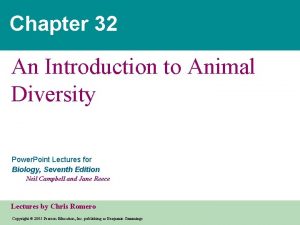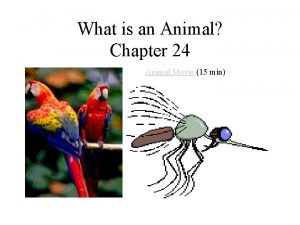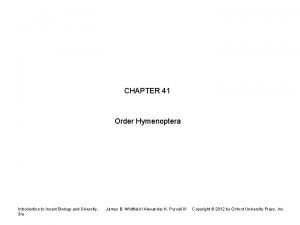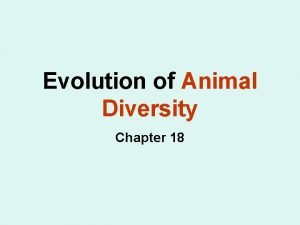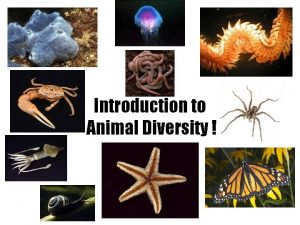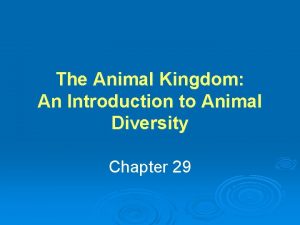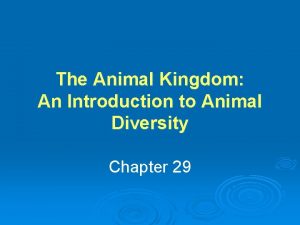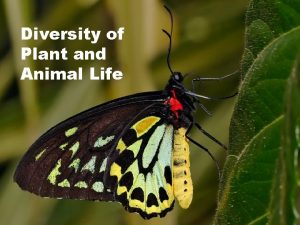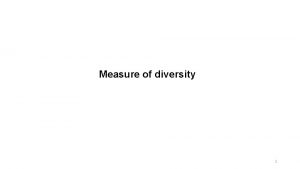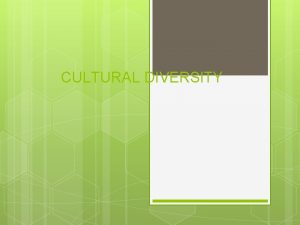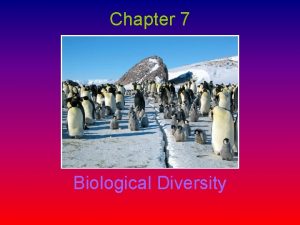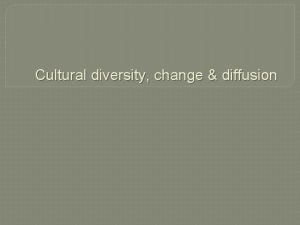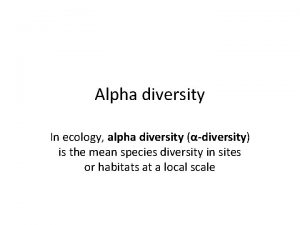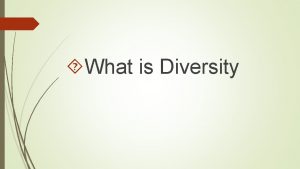Introduction to Animal Diversity and more animal diversity

















- Slides: 17

Introduction to Animal Diversity !

and more animal diversity!

Make a hypothesis: How are these 9 animal phyla related? Draw an evolutionary tree with 9 branches… Arthropods (insects, spiders, crustaceans) Platyhelminthes (flatworms) Mollusks (snails to squids) Nematodes (roundworms) Porifera (sponges) Echinoderms (sea stars, sea urchins) Annelids (segmented worms) Chordates (mostly vertebrates) Cnidaria (jellies)

What do all animals have in common? • Eukaryotic & multicellular with no cell walls • Heterotrophs that ingest food • Specialized cells capable of movement

Symmetry in Animals Bilateral Radial

Many bilaterally symmetrical animals show cephalization - a concentration of senses and brain in the head region

Animal Body Plans Gastrovascular cavity performs dual functions of digestion and gas exchange True digestive system

Protostomes vs. Deuterostomes (which comes first, mouth or anus? )

Tissue Organization Tissue - a collection of specialized cells with a common structure and function - separated from other tissues by a membraneous layer - Ex: muscle tissue, nervous tissue - most (but not all!) animals have specialized tissue layers

Tissue Layers • Form during embryological development (gastrulation) • Blastula (ball of cells) develops germ layers – Ectoderm - Endoderm - Mesoderm • Embryos with two layers (ecto and endo only) are diploblastic • Embryos with all three layers are triploblastic

Diploblast Triploblast Ectoderm Endoderm Mesoderm

Some triploblastic animals have a coelom – a hollow cavity lined with mesoderm tissue that contains internal organs



Segmentation Segment - a distinct section of the body; may be repeating (annelids) or differentiated (arthropods)

Skeletons • Endo • Exo • Hydrostatic

 Lirik lagu more more more we praise you
Lirik lagu more more more we praise you More more more i want more more more more we praise you
More more more i want more more more more we praise you Introduction to animal diversity
Introduction to animal diversity Human history becomes more and more a race
Human history becomes more and more a race Genetic diversity vs species diversity
Genetic diversity vs species diversity Genetic diversity vs species diversity
Genetic diversity vs species diversity Chapter 24 animal evolution diversity and behavior
Chapter 24 animal evolution diversity and behavior 5 apples in a basket riddle
5 apples in a basket riddle The more you study the more you learn
The more you study the more you learn Aspire not to have more but to be more
Aspire not to have more but to be more Law of inertia example
Law of inertia example Knowing more remembering more
Knowing more remembering more More love to thee o lord
More love to thee o lord More choices more chances
More choices more chances Introduction to insect biology and diversity
Introduction to insect biology and diversity Grastula
Grastula General features of animals
General features of animals What is an organelle
What is an organelle


